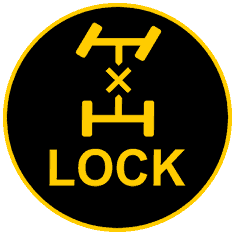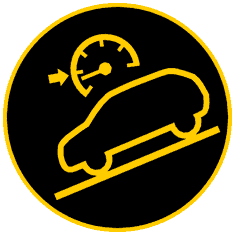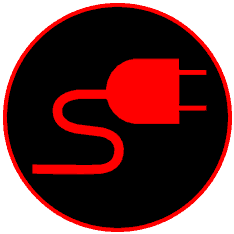Hyundai Santa Fe Dashboard Warning Lights
The Santa Fe SUV has been produced by South Korean car manufacturer Hyundai since the year 2000. The warning lights detailed below include those for the hybrid and non-hybrid versions of the Hyundai Santa Fe / Grand Santa Fe.
 Airbag Warning Light
Airbag Warning Light
Almost all new vehicles are fitted with an airbag system. When the system is working properly, the Hyundai Santa Fe airbag warning light should come on from between 3 to 6 seconds when the ignition switch or engine start button is at the on position.
The warning light should then go off. If it remains on or comes on while you’re driving, it means there’s a problem with:
- Supplemental restraint system (SRS)
- Side airbag system
- Side curtain airbag system
- Seat belt tensioner
Faults often occur due to airbag sensors, airbag module, debris inside the seat belt buckles or dislodged multi-plugs under the front seats. A diagnostic fault code reader is usually recommended to locate the fault.
 Brake Warning Light
Brake Warning Light
As with many warning lights, the Hyundai Santa Fe brake warning light should illuminate when the ignition is switched on. The light should go off shortly after the engine has started. The red brake warning light also comes on when the parking brake is engaged.
If the brake warning light remains lit when the parking brake is disengaged, it means the brake fluid level is low. If this is the case, stop the vehicle when safe to do so, switch off the engine and check brake fluid levels in the reservoir. Brake fluid levels do drop over time as brake pads wear. After topping up with brake fluid, check for signs of a leak.
Check the fluid level in the reservoir periodically. The fluid level should be between MAX and MIN marks on the side of the reservoir. Use only the following brake fluids:
- SAE J1704 DOT-4 LV
- FMVSS 116 DOT-4
- ISO4925 CLASS-6
Only continue driving if there are no signs of brake fluid leak, the warning light goes off and the brakes operate normally.
 ABS Warning Light
ABS Warning Light
Anti-lock Braking Systems (ABS) are fitted to almost all new vehicles. Their purpose is to prevent the wheels from locking up during heavy braking. This results in the driver being able to steer, whereas locked wheels prevent such action.
If the ABS light remains lit in your Hyundai Santa Fe, it means the system is no longer operating. Normal brakes will however continue to work. An ABS wheels speed sensor is located at each wheel. These sensors and wiring are subjected to bad weather conditions and can also become damaged due to road debris. As such, a damaged sensor is usually the cause of a malfunctioning ABS.
ABS and Brake Warning Light
The Hyundai Santa Fe is equipped with an Electronic Brake Force Distribution (EBD) system. The EBD system allows the vehicle to operate brakes on an individual wheel basis, in turn allowing for greater stopping ability. The illumination of both the ABS and red brake warning light indicates a fault with the EBD system.
There is a possibility that the speedometer, odometer, or tripmeter may not work. In addition, the EPS warning light may illuminate and the steering effort may increase or decrease. It’s recommended that you have the brake system services immediately.
 Power Steering Warning Light
Power Steering Warning Light
Modern versions of the Hyundai Santa Fe come equipped with electronic power steering (EPS) rather than hydraulic power steering. This means there’s no hydraulic fluid to check. The EPS warning light can come on for a variety of reasons, including steering sensor, a problem with the power steering motor or wiring issue. As with many modern cars, diagnostic tool used to read fault codes can often help locate the fault.
Sometimes it may be a temporary fault due to the EPS motor overheating. This can occur after continuous steering from left to right lock while the vehicle is stationary. You can usually continue driving when the power steering light is on, but there will be a noticeable difference in difficulty turning the steering wheel, particularly at slower speeds.
 Battery Warning Light
Battery Warning Light
As with many warning lights, the Hyundai Santa Fe battery light should come on when the ignition is switched to the on position and go off when the engine starts. If it stays on, do not drive the vehicle. If the battery light comes on while driving, switch off any electrical accessories and drive immediately to your nearest auto repair shop.
An illuminating battery light means there’s a problem with the electrical charging system and the vehicle’s engine may shut off shortly. Common reasons why the battery light is on can include:
- Alternator
- Alternator drive belt
- Wiring and/or connections
- Ageing battery
 Oil Warning Light
Oil Warning Light
Although this warning light can come on when engine oil levels are low, it’s main purpose is to warn of low engine oil pressure, which can damage the Hyundai Santa Fe engine.
If the low oil pressure light comes on while driving, safely stop, switch off the engine and check oil levels. If the warning light remains on after adding oil or if oil is not available, do not continue driving. Arrange recovery and have your vehicle inspected as soon as possible.
Along with the low oil pressure warning ![]() , the engine malfunction indicator lamp may also illuminate
, the engine malfunction indicator lamp may also illuminate ![]() . In addition, the enhanced engine protection system, which limits the engine’s power may activate. Normal engine power will resume once oil pressure is restored.
. In addition, the enhanced engine protection system, which limits the engine’s power may activate. Normal engine power will resume once oil pressure is restored.
 Engine Warning Light
Engine Warning Light
The Malfunction Indicator Lamp (MIL), also known as the engine warning light comes on when the Hyundai Santa Fe has a fault wit the emissions control system. There are many valves, sensors and engine components that make up the emissions control system. As such, diagnostic equipment is required to narrow down and locate the fault.
When the engine warning light illuminates, a fault code is typically generated and stored. Diagnostic tools are then used to read the fault code and assist in telling the engineer what the problem is.
It’s generally safe to continue driving when the engine light is on for a limited period, but continued driving over a long period may result in damage. If the engine light is flashing, reduce speed and avoid high engine load until the light becomes stable. If the engine light continues to flash, have your Hyundai serviced right away to avoid damage.
 GPF / DPF Warning Light
GPF / DPF Warning Light
To help prevent harmful particles from being released into the environment, filters are used to trap them. For diesel versions a DPF (diesel particulate filter) and gasoline versions, a GPF (gasoline particulate filter). On the Hyundai Santa Fe, DPF or GPF regeneration takes place automatically, often without driver knowledge. On occasions however, if the filter cannot automatically clean itself, driver input may be required to help the cleaning process.
If the GPF or DPF warning light comes on, it means soot inside the filter has accumulated and the filter requires cleaning. To do this, drive the vehicle at more than 50 mph (80km/h) for about 30 minutes (above 3rd gear with 1500 ~ 4000 engine rpm), or until the light goes off. Best results occur on roads that do not require stopping the vehicle.
If after this process, the DPF / GPF warning light remains on, try the process again. If the light still remain lit or begins flashing, it’s likely a forced regeneration will be required. Forced regeneration can be carried out at an Hyundai workshop. Continued driving with the DPF / GPF warning light on may damage the filter and increase fuel consumption.
 EPB Warning Light
EPB Warning Light
In car warning lights, EPB stands for Electronic Parking Brake. The EPB warning light comes on when the ignition is on for around 3 seconds, the goes off. If the EPB warning light remains lit, it means there’s a fault with the Electronic Parking Brake.
One of the more common reasons for an EPB fault is the switch. With constant use, EPB switches wear and require replacement. Other issues may relate to the EPB module, parking brake actuators or wiring. On the Hyundai Santa Fe, if there’s a problem with the ESC system and the ESC warning light comes on, the EPB warning light may also come on. This indicate a problem with the ESC and not the EPB.
 EPB Warning Light
EPB Warning Light
When the driver brakes to a stop, the Hyundai Santa Fe Auto Hold system maintains the vehicle’s brake pressure, keeping the vehicle stationary even when the driver removes their foot from the brake pedal. The brakes are automatically released when the driver presses the accelerator pedal. The Auto Hold light illuminates in a possible three colors:
- White: When the Auto Hold system has been switched on.
- Green: When the driver has fully stopped the vehicle and the vehicle remains stationary by the Auto Hold system.
- Yellow: when a malfunction has occurred with the Auto Hold system.
 Tire Pressure Warning Light
Tire Pressure Warning Light
Most new vehicles come equipped with a tire pressure monitoring system (TPMS). Tire pressure monitoring system either use ‘direct’ system which use sensors located within the vehicle’s tires, or ‘indirect’ system which take advantage of the vehicle’s ABS (wheels speed sensors) to measure the speed of the wheels in order to calculate pressures. The Hyundai Santa Fe uses the ‘direct’ TPMS method.
If the tire pressure light comes on, it means the system has detected at least one tire that’s become underinflated. If the warning light flashes, then remains lit, it means the system’s detected a fault. The tire pressure light can flash for a variety of reasons including:
- Installing tires or wheels that do not meet the manufacturer’s recommendation and prevent the TPMS from functioning correctly.
- A tire (such as the spare) has been installed that does not contain a sensor.
- A sensor has been damaged (this often occurs during a tire change).
- Snow chains are fitted.
- Electronic devices are interfering with the TPMS radio frequencies.
Tire pressure should be checked monthly and when cold. A ‘cold tire‘ is defined as a vehicle that has been sitting for 3 hours or driven for less than 1 mile within that 3 hour period. Inflate the tires to the proper pressure as indicated on the vehicle’s placard or tire inflation pressure label located on the driver’s side center pillar outer panel.
 FCA Warning Light
FCA Warning Light
This warning light comes on when there’s a problem with the Hyundai Santa Fe Forward Collision-Avoidance Assist (FCA) system. Forward Collision-Avoidance Assist monitors and detects vehicles, cyclists and pedestrians ahead in the roadway and warns the driver that a collision is imminent by means of a visual and audible warning. The system can also apply emergency braking.
The system makes use of a forward-facing camera located behind the rear-view mirror and a radar located on the front of the vehicle’s grille. Ensure the windshield and the front grille are kept clean and clear of debris for optimal functionality.
 LKA Warning Light
LKA Warning Light
LKA (Lane Keeping Assist) helps to keep the vehicle between lane lines by alerting the driver by audible and visual alert that they have driven over a lane line without applying a signal. LKA will also apply gently steering back towards the direction of the lane.
The LKA warning light comes on in the following colors:
- Green: When the LKA system is operating and conditions are satisfied.
- White: When the LKA operating conditions are not satisfactory.
- Yellow: when a malfunction has occurred with the Lane Keeping Assist system.
As with the FCA system, LKA uses the camera mounted in the windshield to detect lane lines. Ensure the windscreen, particularly the area where the camera has a view ahead is kept clean.
 4WD Warning Light
4WD Warning Light
The 4wd warning light illuminates when there’s a fault detected with the Hyundai Santa Fe 4 wheel drive system. Problems with the 4wd system are usually related to connection / wiring or sensor faults. When the light illuminates, a trouble code should be stored in the vehicle’s memory. Diagnostics tools are required to retrieve the fault code.
 4WD Lock Light
4WD Lock Light
This light illuminates on your Hyundai Santa Fe dashboard when 4 wheel drive has been locked. 4WD lock distributes your engine’s torque between the front and rear axles and increases the vehicle’s performance in extreme driving conditions such as snow, sand, mud, steep slopes and off-road driving.
4WD lock mode should not be used on dry roads / highway / normal driving conditions due to the potential of damaging 4wd related vehicle components.
 LED Headlight Warning Light
LED Headlight Warning Light
This warning light comes on for around 3 seconds when the ignition is in the ‘on’ position, then goes off. If the light remains on, or comes on or flashes while driving, it means there’s a fault with the LED headlight.
 Icy Road Warning Light
Icy Road Warning Light
The snowflake symbol comes on to warn the driver that the roads might be icy and to drive with extra caution. When the outside temperature falls to approximately 4°C (40°F) or below, the icy road warning light illuminates. The temperature gauge will blink and an audible warning chime will sound.
 DBC Warning Light
DBC Warning Light
DBC, or Downhill Brake Control assists the driver when descending steep slopes by automatically applying the vehicle’s brakes, so that the driver doesn’t have to. This means the driver can concentrate on steering, rather than controlling the speed of the vehicle.
When the DBC light is green, it means the system is in standby mode, green flashing means DBC is operating and if the DBC light is yellow, it means a fault has been detected with the system.
 Auto Stop Warning Light
Auto Stop Warning Light
Auto stop, or Idle Stop and Go (ISG) as Hyundai call it helps to reduce fuel consumption by automatically shutting off the engine when the Santa Fe comes to a standstill. When ISG automatically switches off the engine, the auto stop light illuminates in green.
If conditions are not suitable for the ISG system to shut down the engine, the auto stop light illuminates in white. If the system has malfunction, the warning light illuminates in yellow. Conditions for auto stop to work are as follows:
- The driver has their seat belt buckled
- The driver’s door is properly shut
- The hood is closed
- The battery is sufficiently charged and the battery sensor is activated
- Brake vacuum pressure is adequate
- Temperature outside of the vehicle are not too hot or too cold
- Temperature inside the vehicle is similar to the desired settings
- The engine is sufficiently warmed up
- The vehicle has not stopped on a steep gradient
- When the vehicle has stopped, the steering wheel angle is no more than 180 degrees
 ESC Warning Light
ESC Warning Light
ESC, or Electronic Stability Control is a a vehicle safety stability system that comes as standard on almost all new cars. The system aim to reduce oversteer, understeer and improve tire traction. On the Hyundai Santa Fe, the ESC warning light will blink when the system is actively operating and remain constantly lit when there’s a fault.
ESC uses wheel speed sensors to detect individual wheel speeds and to make corrections by either braking individual wheels, or reducing engine output. Wheel speed sensor are prone to damage either by road debris or by weather due to their location. For more information, see What ESC is in Cars and How Does ESC Work in Cars.
 Immobilizer Warning Light
Immobilizer Warning Light
When the vehicle detects the smart key, the immobilizer warning light comes on for 30 seconds. Vehicles without the smart key, the immobilizer light comes on when the ignition is switched to the on position. The engine can be started.
If the immobilizer light flashes for a few seconds, it means the system cannot detect the smart key and the engine cannot be started. If the immobilizer light illuminates for 2 seconds then goes off, it means the smart key is in the vehicle, the engine start button is in the on position, but the vehicle cannot detect the key. If the immobilizer light flashes, it means there’s a malfunction with the immobilizer system.
The Hyundai Santa Fe immobilizer key warning light remaining on or flashing means there’s either a fault with the electronic receiver that reads the signal from the chip in the key, or the transmitter inside the smart key. Occasionally the smart key may require reprogramming. In terms of the receiver, a common problem is the antenna ring connections on the Immobiliser Control Module (ICM).
 Master Warning Light
Master Warning Light
The Hyundai Santa Fe triangle with an exclamation point is called the master warning light. The master warning light illuminates in yellow when a non-urgent fault has been detected, or there’s maintenance issue.
The master warning light is used where there is no dedicated warning light. A message also displays on the dashboard instrument cluster. For details about the possible warnings related to the master warning light, see Hyundai orange triangle with an exclamation point.
 Water in Fuel Filter
Water in Fuel Filter
For diesel versions of the Hyundai Santa Fe this warning light comes on when water has accumulated in the fuel filter. Fuel filters are usually accessible to reach and must have water drained to prevent excess water from entering the fuel supply. Excess water in the fuel system can damage the engine.
Hyundai Santa Fe Hybrid
The above warning lights apply to both the hybrid and non-hybrid versions of the Hyundai Santa Fe. The following warning lights apply only to the hybrid version.
 Power Gauge
Power Gauge
The Hyundai Santa Fe hybrid power gauge indicates to the driver whether the current driving conditions are fuel efficient, or not. The power gauge is divided into Charge, Eco and Power sections:
- Charge: When the needle is within the charge section, regenerative energy is being produced and stored back into the vehicle’s battery.
- Eco: This section means that the vehicle is being driven in a Eco-friendly manner.
- Power: When in this section, the vehicle is exceeding the Eco-friendly range and will increase fuel/energy consumption.
 Regenerative Braking
Regenerative Braking
On the Hyundai Santa Fe hybrid, the yellow brake warning light is an indication that the regenerative braking is operating as it should. Additionally, the red brake warning light also illuminates, it also means there’s a problem with the vehicle’s brakes.
 HEV Warning Light
HEV Warning Light
The yellow triangle containing HEV and a exclamation point is the Hyundai Santa Fe hybrid vehicle control system warning light. If the warning light comes on while driving, or stays on after starting the vehicle, arrange for an inspection as soon as possible.
 Charging Cable Warning Light
Charging Cable Warning Light
On hybrid versions of the Hyundai Santa Fe, this warning light illuminates in red when the charging cable is plugged in.
 Ready Indicator
Ready Indicator
On hybrid versions of the Hyundai Santa Fe, this light comes on when the vehicle is ready to be driven. If the ready indicator does not come on, normal driving may not be possible. If flashing, it means there is a problem with the vehicle and emergency driving is only possible.
 EV Mode Indicator
EV Mode Indicator
When you see the green EV light, it means the vehicle is being driven only by the electric motor.

Thank you for good information, what about B which shows the back of the car
Thanks, Tichafa.
What about B?
What if the DBC is red?
Hi Eugene,
ABS, ESC and DBC are all related, so could be an issue with this. Also a faulty clutch switch can cause this on the Santa Fe. Diagnostic is the way to go.
wait is a problem with the dash
How to disable the FCA, forward crash alert. This feature is annoying and has been dangerous at highway speeds.
Hi,
The FCA system can be prone to problems, especially in bad weather / snow ice etc where the forward facing camera at the top-center of the windshield and the radar in the vehicle’s front grille get blocked and covered with snow and ice. If you navigate to:
User Settings → Driver Assistance → Forward Safety, you should be able to switch the system off. It may still nag about the radar being blocked, but it shouldn’t be dangerous.
I have a warning sign on my radio screen. It is a b in front of a circle.
Pls where can I get the complete Hyundai Santafe 2008 dashboard to buy?